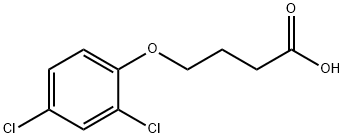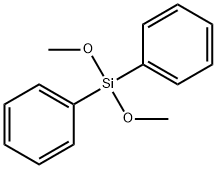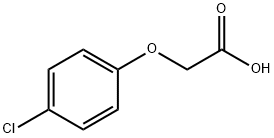2,4-Dichlorophenoxybutyric acid
Synonym(s):2,4-DB;4-(2,4-Dichlorophenoxy)butyric acid
- CAS NO.:94-82-6
- Empirical Formula: C10H10Cl2O3
- Molecular Weight: 249.09
- MDL number: MFCD00002819
- EINECS: 202-366-9
- SAFETY DATA SHEET (SDS)
- Update Date: 2024-12-18 14:15:30

What is 2,4-Dichlorophenoxybutyric acid?
Chemical properties
White to light-brown crystalline solid. May be shipped as a concentrate to be mixed with water and used as a spray. Slight phenolic odor.
The Uses of 2,4-Dichlorophenoxybutyric acid
4-(2,4-Dichlorophenoxy)butanoic Acid is a herbicide.
Definition
ChEBI: A monocarboxylic acid that is butyric acid in which one of the hydrogens at position 4 is replaced by a 2,4-dichlorophenoxy group. A selective post-emergence herbicide.
General Description
Colorless crystals. Slightly corrosive to iron. A chlorinated phenoxy herbicide. Soluble in organic solvents.
Reactivity Profile
2,4-Dichlorophenoxybutyric acid is an organic acid. Neutralizes bases in exothermic reactions. Forms water soluble metal and amine salts. Hard water precipitates the calcium and magnesium salts from aqueous solutions of such salts.
Potential Exposure
2,4-DB is a chlorophenoxy/arylox- yalkanoic acid selective systemic herbicide used to control annual and perennial broadleaf weeds in many field crops such as alfalfa, peanuts, cereals and soybeans; used as a defoliant. In the plant, the compound changes to 2,4-D and inhibits growth at the tips of stems and roots.
Shipping
UN3077 Environmentally hazardous substances, solid, n.o.s., Hazard class: 9; Labels: 9-Miscellaneous haz- ardous material, Technical Name Required.
Incompatibilities
2,4-DB is a weak organic acid. Keep away from oxidizers, sulfuric acid, caustics, ammonia, aliphatic amines, alkanolamines, isocyanates, alkylene oxides, and epichlorohydrin. Corrosive to iron, aluminum, zinc, and possibly other metals, especially in the presence of moisture.
Waste Disposal
Do not discharge into drains or sewers. Dispose of waste material as hazardous waste using a licensed disposal contractor to an approved landfill. Consult with environmental regulatory agencies for guid- ance on acceptable disposal practices. Incineration with effluent gas scrubbing is recommended. Containers must be disposed of properly by following package label directions or by contacting your local or federal environmental control agency, or by contacting your regional EPA office
Properties of 2,4-Dichlorophenoxybutyric acid
| Melting point: | 118-120 °C(lit.) |
| Boiling point: | 324.35 °C |
| Density | 1.3342 (estimate) |
| storage temp. | 0-6°C |
| form | Amorphous Powder |
| pka | 4.56±0.10(Predicted) |
| color | Off-white |
| Water Solubility | 53mg/L(room temperature) |
| Merck | 13,2855 |
| BRN | 1976809 |
| CAS DataBase Reference | 94-82-6(CAS DataBase Reference) |
| NIST Chemistry Reference | Butanoic acid, 4-(2,4-dichlorophenoxy)-(94-82-6) |
| EPA Substance Registry System | 2,4-DB (94-82-6) |
Safety information for 2,4-Dichlorophenoxybutyric acid
| Signal word | Warning |
| Pictogram(s) |
 Exclamation Mark Irritant GHS07  Environment GHS09 |
| GHS Hazard Statements |
H302:Acute toxicity,oral H411:Hazardous to the aquatic environment, long-term hazard |
| Precautionary Statement Codes |
P273:Avoid release to the environment. |
Computed Descriptors for 2,4-Dichlorophenoxybutyric acid
New Products
(S)-3-Aminobutanenitrile hydrochloride 4-Methylphenylacetic acid N-Boc-D-alaninol N-BOC-D/L-ALANINOL Tert-butyl bis(2-chloroethyl)carbamate 3-Morpholino-1-(4-nitrophenyl)-5,6-dihydropyridin- 2(1H)-one Furan-2,5-Dicarboxylic Acid Tropic acid 1-Bromo-3,5-Di-Tert-Butylbenzene S-2-CHLORO PROPIONIC ACID ETHYL ISOCYANOACETATE 2-Bromo-1,3-Bis(Dimethylamino)Trimethinium Hexafluorophosphate 4-IODO BENZOIC ACID 3-NITRO-2-METHYL ANILINE 1-(2,4-DICHLOROPHENYL) ETHANAMINE (2-Hydroxyphenyl)acetonitrile 4-Bromopyrazole 2-(Cyanocyclohexyl)acetic acid 4-methoxy-3,5-dinitropyridine 1-(4-(aminomethyl)benzyl)urea hydrochloride 2-aminopropyl benzoate hydrochloride diethyl 2-(2-((tertbutoxycarbonyl)amino) ethyl)malonate tert-butyl 4- (ureidomethyl)benzylcarbamate Ethyl-2-chloro((4-methoxyphenyl)hydrazono)acetateRelated products of tetrahydrofuran








You may like
-
 2,4-DB CAS 94-82-6View Details
2,4-DB CAS 94-82-6View Details
94-82-6 -
 2033-24-1 98%View Details
2033-24-1 98%View Details
2033-24-1 -
 1975-50-4 98%View Details
1975-50-4 98%View Details
1975-50-4 -
 2-HYDROXY BENZYL ALCOHOL 98%View Details
2-HYDROXY BENZYL ALCOHOL 98%View Details
90-01-7 -
 2-Chloro-1,3-Bis(Dimethylamino)Trimethinium Hexafluorophosphate 221615-75-4 98%View Details
2-Chloro-1,3-Bis(Dimethylamino)Trimethinium Hexafluorophosphate 221615-75-4 98%View Details
221615-75-4 -
 61397-56-6 CIS BROMO BENZOATE 98%View Details
61397-56-6 CIS BROMO BENZOATE 98%View Details
61397-56-6 -
 14714-50-2 (2-Hydroxyphenyl)acetonitrile 98+View Details
14714-50-2 (2-Hydroxyphenyl)acetonitrile 98+View Details
14714-50-2 -
 118753-70-1 98+View Details
118753-70-1 98+View Details
118753-70-1